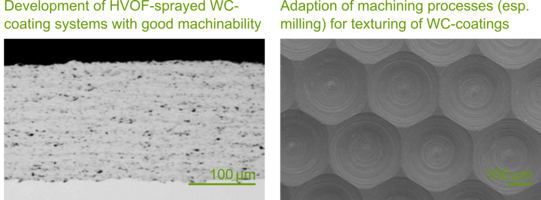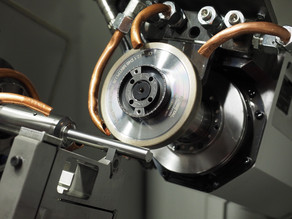CoatingStruc – Innovative Hybrid Manufacturing P rocess of Textured, Thermally Sprayed Surface Systems to Improve Friction Coefficients by up to 10%
Coatings based on tungsten carbide (WC) applied by thermal spraying are well established in the field of surface technology to enhance wear resistance of tribologically stressed surfaces. WC-based coating systems such as WC-Co or WC-CoCr with added cobalt/chromium are applied mostly using high velocity oxygen fuel spraying (HVOF). Compared to uncoated tempered steel, HVOF-sprayed WC-coatings exhibit substantially higher wear resistance when under stress of sliding contact. Because initial surface roughness of HVOF-coatings is high, additional treatment after spraying is necessary for many applications. Thus, a multi-step process consisting of grinding and polishing is often used in industrial production.
Friction occurring between tribologically stressed surfaces like bearing surfaces can be significantly reduced using liquid lubricants for most applications. To allow for continuous lubrication of sliding surfaces, the fluid film needs to be maintained, which can be enhanced using tailored surfaces. The application of surface textures forming lubricant pockets can benefit hydrostatic and -dynamic bearings by significantly reducing the coefficient of friction compared to plain surfaces.
Laser-based processes, which are the most common method used for surface texturing at present, involve unfavourable burr-forming and thermally induced defects. WC-coatings, especially those consisting of sub-microscopic and nano-scale particles, are thermally sensitive and tend to undergo unwanted phase-transitions reducing the surface’s mechanical properties and its service life when exposed to cyclic mechanical stress. Machining technologies like milling implicate these disadvantages to a much lesser extent.
The project’s goal, i.e. to apply bionic and technical textures to thermally sprayed coating, is to be achieved by combining HVOF-spraying and machining with geometrically defined cutting edges (e.g. micro milling) in a novel hybrid manufacturing process. Hereby, the disadvantages of established processes mentioned above can be avoided and the tribological properties of the surface (e.g. coefficient of friction) can be tailored to the application. While maintaining the mechanical properties like wear resistance that are necessary for the application, it is necessary to optimize the composition and microstructure of the coatings for machinability and to adapt the machining process for texturing the difficult to machine coating. In addition to avoiding the shortcomings of laser-based processes, the application of machining can potentially induce compressive residual stresses into the coating to further enhance fatigue strength.





![[Translate to English:] [Translate to English:]](/storages/isf-mb/_processed_/6/9/csm_AG_SimPro_Eyecatcher_1920p--_5f288a9cd4.jpg)